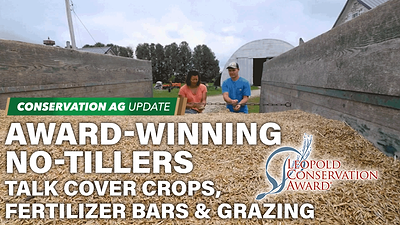Whether you’re a strip-till veteran or simply thinking about trying it out, there’s always something to learn from your fellow farmers.
The Southfork Watershed Alliance, which works with farmers around the Iowa River’s South Fork in central Iowa, invited three local farmers to share their experiences with strip-till during a panel discussion.
Here are some of the highlights of the conversation featuring Chris Blome of Alden, Iowa; Landon Brown of New Providence, Iowa; and Glen Hodnefield of Radcliffe, Iowa.
How did you get started with strip-till?
Brown: I took a full-time job out of college working for my uncle. I was hired to bring strip-till to the farm. I also farm myself, and my own operation has shifted to 100% no-till now so I can work two jobs.
Blome: 2022 is my second year in the strip-till world. I wanted to get into a less labor-intensive farming practice, help improve my fertility and make myself more efficient.
Hodnefield: This past fall was my 25th year of strip-tilling. I also no-till soybeans and have been since 1991. I think the strip-till system works best for corn-on-corn.
What benefits have you gotten from strip-till?
Hodnefield: I know my organic matter has increased. We’re in the 4-5% range. Water-holding capacity of the soil is one of the first benefits I saw when I started strip-tilling 25 years ago. I think that’s where a lot of the benefit comes from when your crops are under stress. Having that moisture in the soil when we hit those dry spots during the season really helps the crop withstand the tough times.
I’ve taken soil temperatures in the spring, and it’s an average of 4-5 degrees warmer in the strip compared to the part that isn’t tilled at all. It’s also drier, and it’s a beautiful seedbed to plant into.
Brown: How does a third less seat time, half the fuel and half the horsepower sound? It’s a lot of savings when you start adding it all up. Time is a big one. I’d rather spend time with my family and doing other stuff.
I like that we’re able to push off some of the workload that we would be doing in the first 5 days in the spring. We can spend that time planting, and the stands we get with strip-till are pretty incredible.
Blome: I agree. I like pushing off the workload into the fall as much as possible. I get all my strips made in the fall, so in the spring we hook up the planter and go.
I convinced myself in fall 2018 to do something different. It was early December and 6 degrees outside, and I was sitting in the ripper wondering what in the world am I doing out in the cold pulling up chunks of dirt frozen 6 inches thick? And how am I going to handle these huge chunks next spring? I was burning 16 gallons of fuel an hour, and then had to go back and put anhydrous on, that’s another 10 gallons an hour, and then the field cultivator. The fuel and time alone are drastically reduced.
What’s your opinion on implement guidance?
Blome: Ideally, you want implement guidance. That’s 100% the best-case scenario. Once you get in the strip with your planter, you stay in the strip. If you have a curve or a contour, you can manually take over and steer out around it. RTK is a must in my opinion.
Brown: Yeah, RTK is pretty awesome. Like Chris said, once you get the planter in the strip, it will just ride there all day. We’re running an RTK-mounted strip-till unit, so that helps with draft.
Hodnefield: Years ago when I started with strip-till, I was using markers on my strip-till machine, and I found out in the spring that the planter tended to follow the strip. As far as GPS goes, I use a correction signal. I don’t use RTK. I had issues with RTK.
How are you applying phosphorus (P) and potassium (K)?
Blome: We’re broadcast spreading over the top.
Brown: We broadcast mainly. We’re looking to go to a liquid in the strip system, but we’re still tweaking that.
Hodnefield: I band dry P, K and sulfur in the fall. I have a unit that I pull, along with anhydrous. I’m putting anhydrous down about 7 inches or so, and then the P and K go through the same knife with a different tube. That’s about 4-5 inches deep. I’m putting all the nutrients under the plant and then plant on top of that in the spring.
Listen to the podcast
This panel conversation continues online. Click here to hear more from these three Iowa strip-tillers, including Chris Blome’s top lesson learned in his first year of strip-tilling.
How are you managing corn stalk residue?
Blome: I learned in 2020 that chopping corn stalks makes a big mat, and it’s very hard to manage that. In 2021, I used a Stalk Devastator from Yetter to bend the stalks over to try to drop the residue straight down the rows.
Hodnefield: I put Stalk Stompers on my corn head, and I see a couple of benefits. One of them is I can tell what direction the combine ran. That helps when we come back and no-till beans because when we spray, there’s a direct line to follow with the sprayer. The Stalk Stompers have also reduced stubble damage to my tires by 90%.
Brown: I combine as high as possible. The more trash we can leave vertical, the better off we are. Usually we’re running rye, too, so that will take some of that, and we’ll still have trash to catch rainfall there. We also started running some Stompers to knock it down right in the row.







